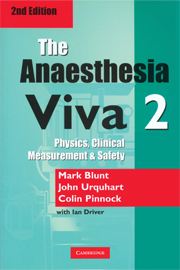Book contents
- Frontmatter
- Foreword to the First Edition
- Preface to the Second Editions
- Contents
- Physics, Clinical Measurement & Safety
- Clinical Anaesthesia
- Example 1
- Example 2
- 6 Example 3
- 7 Example 4
- Example 5
- Example 6
- Example 7
- Example 8
- Example 9
- Example 10
- Example 11
- Example 12
- Example 13
- Example 14
- Appendix 1
- Appendix 2
- Index
6 - Example 3
Published online by Cambridge University Press: 05 February 2015
- Frontmatter
- Foreword to the First Edition
- Preface to the Second Editions
- Contents
- Physics, Clinical Measurement & Safety
- Clinical Anaesthesia
- Example 1
- Example 2
- 6 Example 3
- 7 Example 4
- Example 5
- Example 6
- Example 7
- Example 8
- Example 9
- Example 10
- Example 11
- Example 12
- Example 13
- Example 14
- Appendix 1
- Appendix 2
- Index
Summary
Scenario
You are called to Accident and Emergency to see a 76-year-old man with burns. What would make you suspect the presence of an inhalational injury?
Consider the direct effects of burns on the airway as well as the metabolic consequences such as carboxyhaemoglobinaemia. Inhalational injury must be considered if there is a history of entrapment in an enclosed space, and is less likely, though not impossible, with an electrical burn.
Other indicators are:
▪ Facial involvement of burns
▪ Burnt nares, soot in nose
▪ Stridor, which is an indication for immediate tracheal intubation
▪ Evidence at laryngoscopy
Retrospective carbon monoxide (CO) estimation
The lab co-oximeter will quantify CO levels (but, of considerable importance, the bedside oximeter will not, and cannot distinguish carboxyhaemoglobin (COHb) from oxyhaemoglobin. A patient whose haemoglobin is apparently 99% saturated according to a pulse oximeter may be dying of hypoxia). If the time of injury is known, the exposure levels of CO may be calculated from a nomogram and inhalation injury inferred if a high level is calculated. Presence of COHb is also associated with inhalation of other toxins such as cyanide produced by burning plastics.
The treatment of carboxyhaemoglobinaemia depends on displacement of the CO from the Hb molecule to which it is very tightly bound. The half-life of COHb is 250 minutes in air, 50 minutes in 100% O2, and 22 minutes in a hyperbaric chamber at 2.5 atmospheres.
- Type
- Chapter
- Information
- The Anaesthesia Viva , pp. 89 - 91Publisher: Cambridge University PressPrint publication year: 2003

